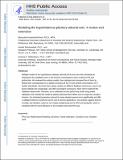Modeling the hypothalamus–pituitary–adrenal axis: A review and extension
Author(s)
Hosseinichimeh, Niyousha; Rahmandad, Hazhir; Wittenborn, Andrea K.
DownloadModeling the hypothalamus.pdf (3.395Mb)
PUBLISHER_CC
Publisher with Creative Commons License
Creative Commons Attribution
Terms of use
Metadata
Show full item recordAbstract
Multiple models of the hypothalamus–pituitary–adrenal (HPA) axis have been developed to characterize the oscillations seen in the hormone concentrations and to examine HPA axis dysfunction. We reviewed the existing models, then replicated and compared five of them by finding their correspondence to a dataset consisting of ACTH and cortisol concentrations of 17 healthy individuals. We found that existing models use different feedback mechanisms, vary in the level of details and complexities, and offer inconsistent conclusions. None of the models fit the validation dataset well. Therefore, we re-calibrated the best performing model using partial calibration and extended the model by adding individual fixed effects and an exogenous circadian function. Our estimated parameters reduced the mean absolute percent error significantly and offer a validated reference model that can be used in diverse applications. Our analysis suggests that the circadian and ultradian cycles are not created endogenously by the HPA axis feedbacks, which is consistent with the recent literature on the circadian clock and HPA axis.
Date issued
2015-08Department
Sloan School of ManagementJournal
Mathematical Biosciences
Publisher
Elsevier
Citation
Hosseinichimeh, Niyousha; Rahmandad, Hazhir and Wittenborn, Andrea K. “Modeling the Hypothalamus–pituitary–adrenal Axis: A Review and Extension.” Mathematical Biosciences 268 (October 2015): 52–65. © 2015 Elsevier Inc
Version: Author's final manuscript
ISSN
0025-5564